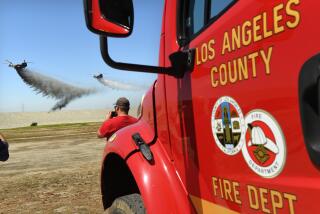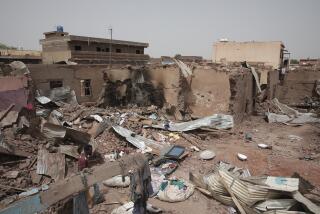A YEAR OF GIVING--AND GIVING
- Share via
Up in the Hills of Beverly, beneath the Hollywood sign and all across the split-level, three-bedroom, two-bath expanse that is America, pop music is asking the African Question one more time:
Don’t they know its Christmas?
CBS-TV answers at 8 Tuesday night with a resounding, “You bet your sweet charity they do.” The hour special, “We Are the World: A Year of Giving,” is designed to boost sagging sales of the album “We Are the World,” plus other pop charity products that have cropped up this year.
The USA for Africa Foundation is especially anxious that LP sales pick up so that CBS Records will be persuaded to release more than $10 million in royalties that it is withholding, says foundation attorney Jay Cooper. That’s about a fourth of USA for Africa’s total earnings so far. The money is being held in reserve because CBS told the foundation that it won’t pay on what it estimates is $12 million in records and cassettes which have been shipped to retailers but not sold.
The TV special focuses on all four major celebrity-studded charity events of the past year: USA for Africa, Live Aid, Band Aid and Farm Aid. Hosted by USA for Africa co-founder Harry Belafonte, the program is billed as a blend of concert footage and famine film, bringing together the most vivid elements of charity rock and charity need.
Cooper and USA for Africa president Ken Kragen acknowledge that it also is an unabashed attempt to keep the great Middle Class contributing to Africa, farmers and America’s own needy.
Despite such continuing promotions, questions about the charity linger. This may be the Year of Giving, but it hasn’t been much in the way of the Year of Spending.
The same charities that are now encouraging even more giving continue to debate the best and most efficient ways to spend the $100 million raised by the albums and concerts--and in the meantime, the bulk of the money remains in Bank of America and Security Pacific vaults collecting interest that helps to pay the charities’ overhead.
Despite the media-inspired sense of compassion and urgency created when the world was stirred by the Ethiopian famine, to date USA for Africa has actually spent only about $5 million of the $36 million that the instant foundation has taken in.
That includes about $1 million spent for donated supplies plus expenses during the celebrated fact-finding trip into Africa last June by Kragen, Belafonte, et al.
Even though most of the money hasn’t been spent, USA for Africa’s board of directors has allocated $34 million to relief agency projects in nine African nations over the next two years.
Most of that money is earmarked for long-term recovery projects that will tap the USA for Africa coffers a little at a time over a period of months or even years.
Kragen and USA for Africa executive director Marty Rogol continue to say that quick spending without strict accountability is an open invitation to mismanagement.
“They don’t always like it, but we put private voluntary organizations through the type of hoops that we do because we want to get the most for the money,” said USA for Africa procurement and distribution director Tracy Gordon.
Charles Moed, a USA for Africa official who returned two weeks ago from a six-week inspection tour of USA for Africa projects in the Sudan and Ethiopia, pointed out that the foundation would receive just as much or more criticism if it spent the “We Are the World” money fast but ineffectively. Even its millions, selectively spent, cannot save the dying continent without heavy, long-term multi-billion dollar aid from Western governments.
“That’s the only way these countries are going to avoid being dependent on these emotional outbursts of generosity (like Live Aid and USA for Africa),” Moed said.
One way Gordon says he’s trying to maximize the USA for Africa millions is through a “leveraging” policy he began several weeks ago. Contractors competing for USA for Africa business are given an edge if they offer to donate goods or services or give discounts to the USA for Africa cause.
By shopping for discounts and donations, Gordon said he expects to stretch USA for Africa’s buying power by $3-$4 million.
Meantime, USA for Africa’s fledgling bureaucracy of about 15 people pays its way either through accepting donations (foundation headquarters on the 14th floor of a Century City office building is contributed rent free) or by using the interest generated by its bank accounts.
USA for Africa’s actual emergency expenditures in Africa so far cover a broad range of specific items, including such things as shoes for Ethiopian children ($15,000), a Landcruiser for refugee work in Chad ($17,000) and five forklifts for Mozambique ($100,000).
“I got the feeling that a lot of the money is getting over there,” said Moed.
Moed said it was difficult to quantify just how much of the West’s pop music charity money was getting to worthy projects in the most afflicted sections of central Africa, but he echoed UNICEF’s director of special projects, Peter Hansen, in pointing to recently released United Nations statistics that show the number of “at-risk” African countries have shrunk from 26 at the beginning of 1985 to only 12 as of last month.
The U.N. report attributes much of Africa’s current recovery to that beleaguered continent’s first good rainy season in more than a decade, but does not downplay the role of Western governments and private agencies--including pop music charities like Band Aid and USA for Africa--in taking Africa from famine to relative feasting.
Moed confirmed the U.N. findings, saying that emotions were running high in both Ethiopia and the Sudan when he visited there last month. A good harvest followed late summer storms that seem to have temporarily staunched the drought, he said.
More to Read
The biggest entertainment stories
Get our big stories about Hollywood, film, television, music, arts, culture and more right in your inbox as soon as they publish.
You may occasionally receive promotional content from the Los Angeles Times.










